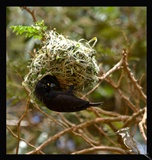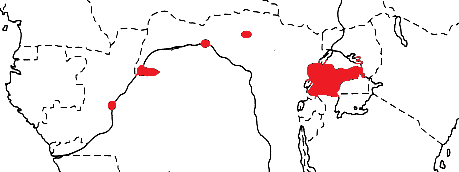Weaver species
Choose different species from drop-down list and press 'Go' button. See Full species list.Weyns's Weaver Ploceus weynsi
IUCN: Least concern Discovery: 101Categories: wetland, fruit,
News items about species
Discovery
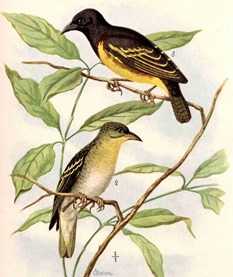
figure from Dubois (1905) 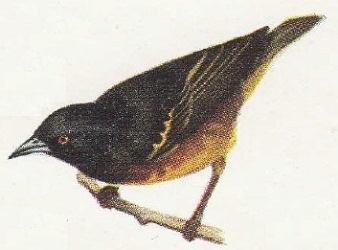
figure from Mackworth (1955) 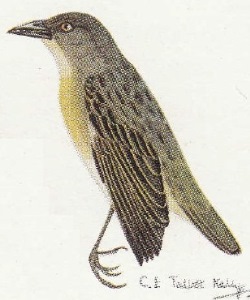
figure from Mackworth (1955) 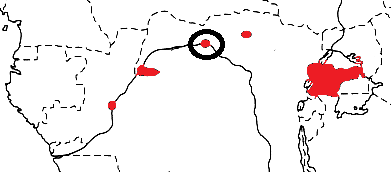
distribution, type locality circled IntroductionThe Weyns's Weaver was formally described by Alphonse Joseph Charles Dubois, a Belgian naturalist and curator of the department of vertebrates at the Royal Museum of Natural History in Brussels.The Weyns's Weaver was collected by Auguste Francois Guillaume Weyns, a Belgian Lieutenant-Colonel and explorer. Weyns visited Africa four times before retiring in 1900, the first trip being to the village of Banana, Congo in 1888. In 1890 Weyns was appointed to protect the construction of the railway which was to connect Matadi to Stanley Pool. From 1894 to 1897 he again worked to protect the Company Railway in Belgian Congo. Weyns had wide interests and during this time he took many photos (eg published in the French magazine Congo illustre), and collected many specimens (plants, mammals, birds and insects). In 1898 the Congo Museum was established in Tervuren. Weyns left Antwerp on 11 June 1898 on board the Albertville steamer to attend the opening of the Congo Railroad. He travelled much of the state, as far as the Stanley Falls and visited the lower reaches of several major tributaries of the river. He returned to Belgium on 9 August 1899, contributing many zoological, botanical, anthropological, geological, paleontological specimens and photographs to the Tervuren Museum. It is most likely on the 1898-1899 trip that Weyns collected the weaver that was later named after him. 11 of the 15 collected specimens of Weyns's Weaver are still at Tervuren Museum. The first illustration of the Weyns's Weaver was of the adult male and female, published by Dubois (1905). The next illustrations were published 50 years later by Mackworth (1955). Scientific citationMelanopteryx weynsi Dubois 1900a, Orn. Monatsb. 8: p.69, Bumba, Congo River, northern Belgian Congo.Meaning of namesweynsi, Named after Lieutenant Colonel A.F.G. Weyns (1854-1944) Belgian explorer and collector in tropical Africa, 1888-1903.First English nameWeyns's Black-headed Weaver (Shelley 1905b).Alternate namesWeyns's Black-headed Weaver, Weyns's Yellow-bellied Black Weaver.CollectorAuguste F G Weyns.Date collectedBetween 1888-1900, probably 1898-1899.Locality collectedBumba, Congo River, DR Congo.Type specimens11 of the 15 types are in the Tervuren Museum. |
The above is based on Weaver Wednesday 2, a weekly series about the discovery of each weaver species.
This species text first appeared as
Weaver Wednesday [218] - Discovery [101]: Weyns's Weaver on 2016-08-17
1. Basic biology
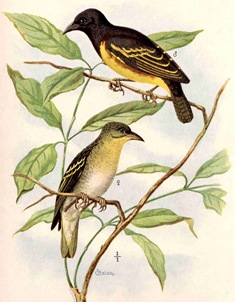
figure from Dubois 1905 The female has plain olive-green upperparts and face, with a pale eye but no supercilium. The female is separated from very similar female Vieillot's Black Weaver by a blackish bill, green tail and yellow underwings. Distribution. The Weyns's Weaver is found in eastern PRCongo, western and northern DRCongo, southern Uganda and NW Tanzania (see map below, based on Birds of Africa). There are no subspecies of the Weyns's Weaver. Habitat. The Weyns's Weaver lives high up in tall forest trees in seasonally dry swamp forest, and also in lush lake shore vegetation. It is restless, with a fast flight. It is usually resident, but may wander erratically, and seems to be absent from the northern shores of Lake Victoria in June-Sept. Food. The Weyns's Weaver feeds on fruit, including wild figs, and most likely is also insectivorous. It forages in pairs and in flocks, mainly in the forest canopy. Feeding flocks are about 20 individuals, and sometimes up to 200 or more. It roosts in flocks, sometimes with other weavers.
Breeding. There is very limited information on the breeding biology of the Weyns's Weaver. There is one record of breeding in a papyrus swamp in Mabamba Bay, Uganda, in February 2006. This resembles the breeding pattern of Clarke's Weaver, of breeding in reeds but otherwise living in forests. One photo of the nest of a Weyns's Weaver, however, is in a tree in Bwindi Impenetrable National Park, Uganda (see here), although the species needs to be confirmed. |
The above is based on Weaver Wednesday, a weekly series about weaver species.
This species text first appeared as
Weaver Wednesday [89]: Weyns's Weaver on 2014-02-26
2. Breeding facts
| Pair bond no information Breeding season Young found in Uganda in Nov, and begging juvenile seen Apr; adults with enlarged gonads in Apr-Jun in DRCongo and Jun-Jul in Uganda Nest site no information Nest building no information Colony size no information Clutch size no information Egg colour no information Egg size no information Incubation no information Chicks and nestling period no information |
Breeding information based on Handbook of the Birds of the World, Vol. 15.
3. Photos of Weaver Nests
 Vm 26363 |
Thumb-nails of most recent PHOWN records - click on one to see its full record
See all PHOWN records for this species here.
PHOWN (Photos of Weaver Nests) provides valuable info on breeding distribution and colony sizes of weavers.
You can contribute by registering and submitting photos at Virtual Museum webpage.
4. Breeding distribution
Google map showing distribution (For species with small ranges you need to zoom in at the correct area to see the range):
yellow blob - range of weaver species; read more about this here.
![]() - PHOWN records with photos
- PHOWN records with photos
![]() - PHOWN records with no photos (Nest Record Cards, other records)
- PHOWN records with no photos (Nest Record Cards, other records)
![]() - Birdpix records
- Birdpix records
![]() - comments on out of range records, or interesting records
- comments on out of range records, or interesting records
![]() - type locality
- type locality
CLICK on the marker on the map to see individual record details.
5. Range changes
Not South African speciesThe above is based on Weaver Wednesday 3, a weekly series about range changes in South African weaver species.
This species text first appeared as
n/a








